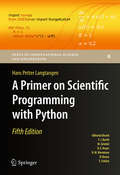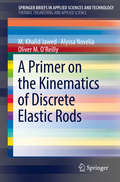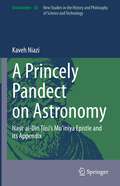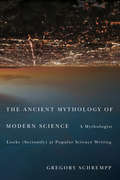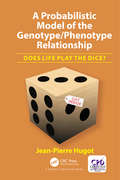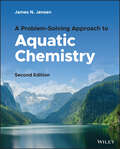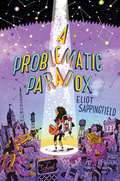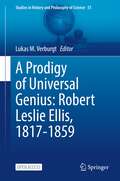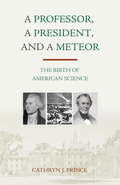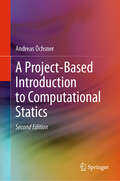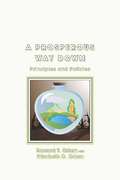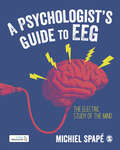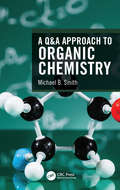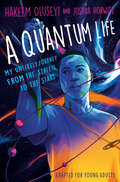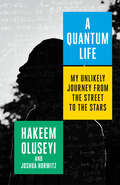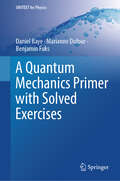- Table View
- List View
A Primer on Scientific Programming with Python (Texts in Computational Science and Engineering #6)
by Hans Petter LangtangenThe book serves as a first introduction to computer programming of scientific applications, using the high-level Python language. The exposition is example and problem-oriented, where the applications are taken from mathematics, numerical calculus, statistics, physics, biology and finance. The book teaches "Matlab-style" and procedural programming as well as object-oriented programming. High school mathematics is a required background and it is advantageous to study classical and numerical one-variable calculus in parallel with reading this book. Besides learning how to program computers, the reader will also learn how to solve mathematical problems, arising in various branches of science and engineering, with the aid of numerical methods and programming. By blending programming, mathematics and scientific applications, the book lays a solid foundation for practicing computational science. From the reviews: Langtangen . . . does an excellent job of introducing programming as a set of skills in problem solving. He guides the reader into thinking properly about producing program logic and data structures for modeling real-world problems using objects and functions and embracing the object-oriented paradigm. . . . Summing Up: Highly recommended. F. H. Wild III, Choice, Vol. 47 (8), April 2010 Those of us who have learned scientific programming in Python 'on the streets' could be a little jealous of students who have the opportunity to take a course out of Langtangen's Primer. " John D. Cook, The Mathematical Association of America, September 2011 This book goes through Python in particular, and programming in general, via tasks that scientists will likely perform. It contains valuable information for students new to scientific computing and would be the perfect bridge between an introduction to programming and an advanced course on numerical methods or computational science. Alex Small, IEEE, CiSE Vol. 14 (2), March /April 2012
A Primer on the Kinematics of Discrete Elastic Rods (SpringerBriefs in Applied Sciences and Technology)
by Oliver M. O'Reilly M. Khalid Jawed Alyssa NoveliaThis primer discusses a numerical formulation of the theory of an elastic rod, known as a discrete elastic rod, that was recently developed in a series of papers by Miklós Bergou et al. Their novel formulation of discrete elastic rods represents an exciting new method to simulate and analyze the behavior of slender bodies that can be modeled using an elastic rod. The formulation has been extensively employed in computer graphics and is highly cited. In the primer, we provide relevant background from both discrete and classical differential geometry so a reader familiar with classic rod theories can appreciate, comprehend, and use Bergou et al.’s computational efficient formulation of a nonlinear rod theory. The level of coverage is suitable for graduate students in mechanics and engineering sciences.
A Primer to Causal Reasoning About a Complex World (SpringerBriefs in Philosophy)
by Volker Grimm Maja Schlüter Lars-Göran Johansson Petri Ylikoski Thomas Banitz Tilman Hertz Emilie Lindkvist Rodrigo Martínez Peña Sonja RadosavljevicThis open access book is about causal thinking and the use of causal language, with a focus on introducing philosophical ideas about causation to students and researchers of Social-Ecological Systems (SES). It takes a systematic approach to three central topics: the meanings of different causal expressions, sufficiency of evidence for inferences from observations to causal relations, and how to handle the complexity of causal relations in social-ecological systems. Consequently, the book is divided into three parts. In the first part the authors analyse and discuss the use of causal idiom in ordinary language, and in the second part they scrutinise the use of causal concepts and causal inference in science. Finally, the authors discuss causal reasoning about social-ecological systems in multi- and interdisciplinary contexts. This book provides an analysis of the concept of causation useful in the empirical sciences, where causal notions and idioms often are used without sufficient reflection. Empirical sciences often use causal idiom drawn from ordinary language, and similarly there is little formalisation of causal language and technical concepts in the humanities and social sciences. This book is a valuable resource for the application of current philosophical discussions about the concept of causation, in particular when applied to the analysis of social-ecological systems, but also when applied to research in the sciences and humanities.
A Princely Pandect on Astronomy: Naṣīr al-Dīn Ṭūsī's Muʿīnīya Epistle and its Appendix (Archimedes #58)
by Kaveh NiaziThis book presents an English-language translation of Risālā-yi Muʿīnīya, or the Muʿīnīya Epistle. Risālā-yi Muʿīnīya is one of the earliest known works of Naṣīr al-Dīn Ṭūsī (1201–1274), an intellectual luminary of the 13th century CE. The work is notable for the choice of Ṭūsī’s native Persian as the language of the text. In addition, Ṭūsī organized his volume into a four-part structure, which went on to become a popular template for the Islamic astronomers who succeeded him. This book helped ensure the patronage of Ṭūsī's courtly patrons during his decades-long stay with the Ismaʿīlīs, as well as the continuation of his remarkable career under the first Ilkhanid rulers of Persia. This translation helps make this notable treatise accessible to English language readers. It is among a handful of English translations of major astronomical works dealing with hay’a/cosmography in the Islamic world. Subsequently Ṭūsī was to pen his own commentary on the work (the Ḥall-i Mushkilāt-i Muʿīnīya, or A solution to the difficulties of the Muʿīnīya) and he used this occasion to discuss his celebrated mathematical formulation “the Ṭūsī Couple” (a concept that he merely hinted at in the Risālā-yi Muʿīnīya).
A Priori: A Mythologist Looks (Seriously) at Popular Science Writing (Central Problems of Philosophy)
by Gregory SchremppHumans have long been captivated by mythology and theorized about the lessons embedded in their tales. In The Ancient Mythology of Modern Science, Gregory Schrempp brings a mythologist's critical eye to popular science writing, a flourishing genre that forms a key link between science and popular consciousness. Schrempp argues that the defining and appealing characteristic of this genre is not simplification or "dumbing-down," but the attempt to parlay scientific findings into aesthetically and morally compelling visions that offer guidance for humanity. Schrempp argues that in striving for inspirational visions, popular science invariably reproduces - with ingenious invention - the structures, strategies, and cosmic imagery that infuse traditional mythological views of the cosmos. His claim challenges the widespread tendency to separate myth and science. Schrempp considers both the intellectual history of mythography and concrete examples from world mythologies including ancient Greek, Oceanic, and Native American. Schrempp's explorations span a range of fields, including astronomy, evolutionary biology, and cognitive science. In a world informed, transformed, and sometimes mesmerized by science, this book offers the first in-depth study of popular science writing from a mythologist's perspective.
A Probabilistic Model of the Genotype/Phenotype Relationship: Does Life Play the Dice?
by Jean-Pierre HugotA Probabilistic Model of the Genotype/Phenotype Relationship provides a new hypothesis on the relationship between genotype and phenotype. The main idea of the book is that this relationship is probabilistic, in other words, the genotype does not fully explain the phenotype. This idea is developed and discussed using the current knowledge on complex genetic diseases, phenotypic plasticity, canalization and others.
A Problem-Solving Approach to Aquatic Chemistry
by James N. JensenA Problem-Solving Approach to Aquatic Chemistry Enables civil and environmental engineers to understand the theory and application of aquatic equilibrium chemistry The second edition of A Problem-Solving Approach to Aquatic Chemistry provides a detailed introduction to aquatic equilibrium chemistry, calculation methods for systems at equilibrium, applications of aquatic chemistry, and chemical kinetics. The text directly addresses two required ABET program outcomes in environmental engineering: “… chemistry (including stoichiometry, equilibrium, and kinetics)” and “material and energy balances, fate and transport of substances in and between air, water, and soil phases.” The book is very student-centered, with each chapter beginning with an introduction and ending with a summary that reviews the chapter’s main points. To aid in reader comprehension, important terms are defined in context and key ideas are summarized. Many thought-provoking discussion questions, worked examples, and end of chapter problems are also included. Each part of the text begins with a case study, a portion of which is addressed in each subsequent chapter, illustrating the principles of that chapter. In addition, each chapter has an Historical Note exploring connections with the people and cultures connected to topics in the text. A Problem-Solving Approach to Aquatic Chemistry includes: Fundamental concepts, such as concentration units, thermodynamic basis of equilibrium, and manipulating equilibria Solutions of chemical equilibrium problems, including setting up the problems and algebraic, graphical, and computer solution techniques Acid–base equilibria, including the concepts of acids and bases, titrations, and alkalinity and acidity Complexation, including metals, ligands, equilibrium calculations with complexes, and applications of complexation chemistry Oxidation-reduction equilibria, including equilibrium calculations, graphical approaches, and applications Gas–liquid and solid–liquid equilibrium, with expanded coverage of the effects of global climate change Other topics, including chemical kinetics of aquatic systems, surface chemistry, and integrative case studies For advanced/senior undergraduates and first-year graduate students in environmental engineering courses, A Problem-Solving Approach to Aquatic Chemistry serves as an invaluable learning resource on the topic, with a variety of helpful learning elements included throughout to ensure information retention and the ability to apply covered concepts in practical settings.
A Problematic Paradox
by Eliot SappingfieldGuardians of the Galaxy meets The Hitchhiker's Guide to the Galaxy in this wild, warm-hearted, and hilarious sci-fi debut about a brainy young girl who is recruited for a very special boarding school. <P><P> Nikola Kross has given up on living in harmony with classmates and exasperated teachers: she prefers dabbling in experimental chemistry to fitting in. But when her life is axially inverted by a gang of extraterrestrials who kidnap her dad and attempt to recruit her into their service, she discovers he's been keeping a world of secrets from her--including the school for geniuses where she's sent for refuge, a place where classes like Practical Quantum Mechanics are the norm and where students use wormholes to commute to class. For Nikola, the hard part isn't school, it's making friends, especially when the student body isn't (entirely) human. <P><P> But the most puzzling paradox of all is Nikola herself, who has certain abilities that no one understands--abilities that put her whole school in greater danger than she could have imagined.* <P><P> "A glorious cacophony of wildly inventive gadgets, gags, and action." --Kirkus Reviews, starred review
A Prodigy of Universal Genius: Robert Leslie Ellis, 1817-1859 (Studies in History and Philosophy of Science #55)
by Lukas M. VerburgtThis open access book brings together for the first time all aspects of the tragic life and fascinating work of the polymath Robert Leslie Ellis (1817–1859), placing him at the heart of early-Victorian intellectual culture. Written by a diverse team of experts, the chapters in the book’s first part contain in-depth examinations of, among other things, Ellis’s family, education, Bacon scholarship and mathematical contributions. The second part consists of annotated transcriptions of a selection of Ellis’s diaries and correspondence. Taken together, A Prodigy of Universal Genius: Robert Leslie Ellis, 1817–1859 is a rich resource for historians of science, historians of mathematics and Victorian scholars alike. Robert Leslie Ellis was one of the most intriguing and wide-ranging intellectual figures of early Victorian Britain, his contributions ranging from advanced mathematical analysis to profound commentaries on philosophy and classics and a decisive role in the orientation of mid-nineteenth century scholarship. This very welcome collection offers both new and authoritative commentaries on the work, setting it in the context of the mathematical, philosophical and cultural milieux of the period, together with fascinating passages from the wealth of unpublished papers Ellis composed during his brief and brilliant career.- Simon Schaffer, Department of History and Philosophy of Science, University of Cambridge
A Produce Reference Guide to Fruits and Vegetables from Around the World: Nature's Harvest
by Donald D HeatonA Produce Reference Guide to Fruits and Vegetables from Around the World: Nature's Harvest answers the many questions consumers have about various fruits and vegetables. Providing basic, clear, and understandable information for each produce item, this reference guide gives you a synopsis of the fruit or vegetable, a short history of the item, the common and uncommon name, what it looks and tastes like, how it is used, and the time of year it is available. Information on nutrition, serving sizes, yields, and optimal storage conditions is also provided. From potatoes to shepherd's purse and from grapes to the Clementine tangor, A Produce Reference Guide to Fruits and Vegetables from Around the World covers both the familiar and the exotic. Other than the obvious fruits and vegetables (such as 12 varieties of cherries and 10 different kinds of squash) you'll also read about herbs, mushrooms, sprouts, and nuts.
A Professional’s Guide to Feline Behaviour: Understanding, Improving and Resolving Problems
by Caroline ClarkA Professional's Guide to Feline Behaviour is an invaluable resource for the feline professional, yet written in such an accessible way that it would be of interest to anyone who shares their life with a cat and wants to gain a deeper understanding of their behaviour.The book is presented in easy-to-navigate sections, each packed with practical advice and the colour illustrations, tables and graphics throughout make it approachable for every type of reader.What this guide offers: A greater understanding of cats and how to meet their needs. How to recognise and mitigate negative emotions and deal with challenges that cats face both at home and particularly in the workplace. How to analyse feline behaviour accurately, with a view to designing a tailored behaviour modification plan. Comprehensive information on common, and not so common, problematic feline behaviours. The fundamentals of learning theory, with step-by-step training guides. Real-life case studies, accompanied by behaviour plans that integrate clinically proven methods to help manage or resolve a range of behaviour issues. Written by Caroline Clark, a Registered Clinical Animal Behaviourist and RCVS listed veterinary nurse, this well-researched book draws from her knowledge and professional experiences, offering a unique insight into feline behaviour.
A Professor, A President, and A Meteor
by Cathryn J. PrinceWhen a fiery meteor crash in 1807 lit up the dark early-morning sky in Weston, Connecticut, it did more than startle the few farmers in the sleepy village. More importantly, it sparked the curiosity of Benjamin Silliman, a young chemistry professor at nearby Yale College. His rigorous investigation of the incident started a chain of events that eventually brought the once-low standing of American science to sudden international prominence. And, by coincidence, the event also embroiled Silliman in politics, pitting him against no less an adversary than President Thomas Jefferson. Based on a wealth of original source documents and interiews with current experts in history, astronomy, and geology, this journalist tells the remarkable story of Benjamin Silliman, arguably America's first bonafide scientist. In a lively narrative rich with fascinating historical detail, the author documents the primitive state of American science at the time; Silliman's careful analysis of the meteor samples; and the publication of his conclusions, which contradicted both popular superstitions regarding meteors as ominous portents and a common belief that meteors come from volcanic eruptions on the moon. She also describes Silliman's struggles to build a chemistry department at Yale with rudimentary material; new insights into geology that resulted from his analysis of the meteor; and his report to the prestigious French Academy, which raised the prestige of American science. Finally, she discusses the political turbulence of the time, which Silliman could not escape, and how the meteor event was used to drive a wedge between New England and Jefferson. This is a fascinating vignette of Federal Period America when science on this continent was still in its infancy, but was just beginning to make its mark.
A Project-Based Introduction to Computational Statics
by Andreas ÖchsnerThis book uses a novel concept to teach the finite element method, applying it to solid mechanics. This major conceptual shift takes away lengthy theoretical derivations in the face-to-face interactions with students and focuses on the summary of key equations and concepts; and to practice these on well-chosen example problems. For this new, 2nd edition, many examples and design modifications have been added, so that the learning-by-doing features of this book make it easier to understand the concepts and put them into practice. The theoretical derivations are provided as additional reading and students must study and review the derivations in a self-study approach. The book provides the theoretical foundations to solve a comprehensive design project in tensile testing. A classical clip-on extensometer serves as the demonstrator on which to apply the provided concepts. The major goal is to derive the calibration curve based on different approaches, i.e., analytical mechanics and based on the finite element method, and to consider further design questions such as technical drawings, manufacturing, and cost assessment. Working with two concepts, i.e., analytical and computational mechanics strengthens the vertical integration of knowledge and allows the student to compare and understand the different concepts, as well as highlighting the essential need for benchmarking any numerical result.
A Prosperous Way Down
by Howard T. Odum Elisabeth C. OdumA Prosperous Way Down, the last book by Howard T. and Elisabeth C. Odum, has shaped politics and planning as nations, states, and localities begin the search for ways to adapt to a future with vastly increased competition for energy. It considers ways in which a future with less fossil fuel could be peaceful and prosperous. Although history records the collapse of countless civilizations, some societies and ecosystems have managed to descend in orderly stages, reducing demands and selecting and saving what is most important. The authors make recommendations for a more equitable and cooperative world society, with specific suggestions based on their evaluations of trends in global population, wealth distribution, energy sources, conservation, urban development, capitalism and international trade, information technology, and education. Available for the first time in paperback, this thoughtful, provocative book forces us to confront assumptions about our world 's future and provides both a steadying hand and a call to action with its pragmatic analysis of a global transition.
A Psychologist’s guide to EEG: The electric study of the mind
by Michiel SpapéDo you want to learn to read people′s minds? In this student-friendly, practice-focussed textbook on EEG and biosignal analysis, you will learn how to: Implement your experiment in E-Prime or OpenSesame; Run your study in the psychophysiological laboratory; Analyse data in MATLAB by following simple steps. This textbook follows a unique approach by guiding you through a single EEG study, each part introducing the relevant core knowledge and commonly available software. Practical exercises help you master the skills to independently implement every aspect of an experiment, from setting up the lab to analysing the data. Suitable for developing both basic levels of skill for undergraduates as well as advancing towards a stronger command of analysis and understanding at postgraduate level. Michiel Spapé is a Lecturer and Researcher in Psychology at the University of Helsinki.
A Psychologist’s guide to EEG: The electric study of the mind
by Michiel SpapéDo you want to learn to read people′s minds? In this student-friendly, practice-focussed textbook on EEG and biosignal analysis, you will learn how to: Implement your experiment in E-Prime or OpenSesame; Run your study in the psychophysiological laboratory; Analyse data in MATLAB by following simple steps. This textbook follows a unique approach by guiding you through a single EEG study, each part introducing the relevant core knowledge and commonly available software. Practical exercises help you master the skills to independently implement every aspect of an experiment, from setting up the lab to analysing the data. Suitable for developing both basic levels of skill for undergraduates as well as advancing towards a stronger command of analysis and understanding at postgraduate level. Michiel Spapé is a Lecturer and Researcher in Psychology at the University of Helsinki.
A Q&A Approach to Organic Chemistry
by Michael B. SmithA Q&A Approach to Organic Chemistry is a book of leading questions that begins with atomic orbitals and bonding. All critical topics are covered, including bonding, nomenclature, stereochemistry, conformations, acids and bases, oxidations, reductions, substitution, elimination, acyl addition, acyl substitution, enolate anion reactions, the Diels–Alder reaction and sigmatropic rearrangements, aromatic chemistry, spectroscopy, amino acids and proteins, and carbohydrates and nucleosides. All major reactions are covered. Each chapter includes end-of-chapter homework questions with the answer keys in an Appendix at the end of the book. This book is envisioned to be a supplementary guide to be used with virtually any available undergraduate organic chemistry textbook. This book allows for a "self-guided" approach that is useful as one studies for a coursework exam or as one reviews organic chemistry for postgraduate exams. Key Features: Allows a "self-guided tour" of organic chemistry Discusses all important areas and fundamental reactions of organic chemistry Classroom tested Useful as a study guide that will supplement most organic chemistry textbooks Assists one in study for coursework exams or allows one to review organic chemistry for postgraduate exams Includes 21 chapters of leading questions that covers all major topics and major reactions of organic chemistry
A Quantum Life (Adapted for Young Adults): My Unlikely Journey from the Street to the Stars
by Joshua Horwitz Hakeem OluseyiA NASA astrophysicist narrates his improbable journey from an impoverished childhood and an adolescence mired in drugs and crime to the nation's top physics PhD program at Stanford in this inspiring coming-of-age memoir.Born into extreme poverty and emotional deprivation, James Edward Plummer was blessed with a genius I.Q. and a love of science. But in his community, a young bookworm quickly becomes a target for violence and abuse. As he struggles to survive his childhood in some of the toughest cities in the country, and his teenage years in the equally poor backwoods of Mississippi, James adopts the hybrid persona of a "gangsta nerd"--dealing weed in juke joints while winning state science fairs with computer programs that untangle the mysteries of Einstein's relativity theory.When his prodigious intellect gains him admission to the elite Physics PhD program at Stanford University, James finds himself torn between his love of science and a dangerous crack cocaine habit he developed in college. With the encouragement of his mentor Art Walker, the lone Black faculty member in the physics department, James finally seizes his dream of a life in science and becomes his true adult self, changing his name to Hakeem Muata Oluseyi in honor--and celebration--of his African heritage. In the tradition of The Autobiography of Malcolm X and The Other Wes Moore, A Quantum Life is an uplifting journey to the stars fueled by hope, hustle, and a hungry mind. As he charts his development as a young scientist, Oluseyi also plumbs the mysteries of the universe where potential personal outcomes are as infinite as the stars in the sky.
A Quantum Life: My Unlikely Journey from the Street to the Stars
by Joshua Horwitz Hakeem OluseyiIn this inspiring coming-of-age memoir, a world-renowned astrophysicist emerges from an impoverished childhood and crime-filled adolescence to ascend through the top ranks of research physics. &“You&’ll encounter one extraordinary turn of events after another, as the extraordinary chess player, puzzle solver, and occasional grifter works his way from grinding poverty and deep despair to worldwide acclaim as a physicist.&”—Bill Nye, CEO of The Planetary Society Navigating poverty, violence, and instability, a young James Plummer had two guiding stars—a genius IQ and a love of science. But a bookish nerd is a soft target, and James faced years of bullying and abuse. As he struggled to survive his childhood in some of the country&’s toughest urban neighborhoods in New Orleans, Houston, and LA, and later in the equally poor backwoods of Mississippi, he adopted the persona of &“gangsta nerd&”—dealing weed in juke joints while winning state science fairs with computer programs that model Einstein&’s theory of relativity. Once admitted to the elite physics PhD program at Stanford University, James found himself pulled between the promise of a bright future and a dangerous crack cocaine habit he developed in college. With the encouragement of his mentor and the sole Black professor in the physics department, James confronted his personal demons as well as the entrenched racism and classism of the scientific establishment. When he finally seized his dream of a life in astrophysics, he adopted a new name, Hakeem Muata Oluseyi, to honor his African ancestors. Alternately heartbreaking and hopeful, A Quantum Life narrates one man&’s remarkable quest across an ever-expanding universe filled with entanglement and choice.
A Quantum Life: My Unlikely Journey from the Street to the Stars
by Joshua Horwitz Hakeem OluseyiIn this inspiring coming-of-age memoir, a world-renowned astrophysicist emerges from an impoverished childhood and crime-filled adolescence to ascend through the top ranks of research physics.Navigating poverty, violence, and instability, a young James Plummer had two guiding stars-a genius IQ and a love of science. But a bookish nerd was a soft target in his community, where James faced years of bullying and abuse. As he struggled to survive his childhood in some of the country's toughest urban neighborhoods in New Orleans, Houston, and LA, and later in the equally poor backwoods of Mississippi, he adopted the persona of "gangsta nerd"-dealing weed in juke joints while winning state science fairs with computer programs that model Einstein's theory of relativity. Once admitted to the elite physics PhD program at Stanford University, James found himself pulled between the promise of a bright future and a dangerous crack cocaine habit he developed in college. With the encouragement of his mentor and the sole Black professor in the physics department, James confronted his personal demons as well as the entrenched racism and classism of the scientific establishment. When he finally seized his dream of a life in astrophysics, he adopted a new name, Hakeem Muata Oluseyi, to honor his African ancestors.Alternately heartbreaking and hopeful, A QUANTUM LIFE narrates one man's remarkable quest across an ever-expanding universe filled with entanglement and choice.
A Quantum Life: My Unlikely Journey from the Street to the Stars
by Joshua Horwitz Hakeem OluseyiIn this inspiring coming-of-age memoir, a world-renowned astrophysicist emerges from an impoverished childhood and crime-filled adolescence to ascend through the top ranks of research physics.Navigating poverty, violence, and instability, a young James Plummer had two guiding stars-a genius IQ and a love of science. But a bookish nerd was a soft target in his community, where James faced years of bullying and abuse. As he struggled to survive his childhood in some of the country's toughest urban neighborhoods in New Orleans, Houston, and LA, and later in the equally poor backwoods of Mississippi, he adopted the persona of "gangsta nerd"-dealing weed in juke joints while winning state science fairs with computer programs that model Einstein's theory of relativity. Once admitted to the elite physics PhD program at Stanford University, James found himself pulled between the promise of a bright future and a dangerous crack cocaine habit he developed in college. With the encouragement of his mentor and the sole Black professor in the physics department, James confronted his personal demons as well as the entrenched racism and classism of the scientific establishment. When he finally seized his dream of a life in astrophysics, he adopted a new name, Hakeem Muata Oluseyi, to honor his African ancestors.Alternately heartbreaking and hopeful, A QUANTUM LIFE narrates one man's remarkable quest across an ever-expanding universe filled with entanglement and choice.
A Quantum Mechanics Primer with Solved Exercises (UNITEXT for Physics)
by Daniel Baye Marianne Dufour Benjamin FuksThis book provides a comprehensive introduction to quantum mechanics, supported by numerous solved exercises. Aiming to be both exhaustive and educational, it minimises overly formal aspects by presenting the wave mechanical approach to quantum mechanics. The book simplifies and rigorously covers a large set of fundamental topics such as potential wells and barriers, wave packets, harmonic oscillators, and the hydrogen atom. It also addresses spin and, in simple terms, the conceptual difficulties of quantum physics and Bell’s inequalities. The discussion extends to relativistic quantum mechanics. Each chapter includes exercises designed to test comprehension and facilitate optimal assimilation of the material, and are followed by detailed solutions. Intended for both personal study and course support, this book is valuable for anyone curious about the subject. However, it is specifically targeted at undergraduate and master’s students in physics, chemistry, and mathematics, as well as engineering students.
A Question and Answer Guide to Astronomy
by Roy Carol Christian Jean-RenéAre we alone in the Universe? Was there anything before the Big Bang? Are there other universes? What are sunspots? What is a shooting star? Was there ever life on Mars? This book answers the fascinating questions that we have been asking ourselves for hundreds of years. Using non-technical language, the authors summarize current astronomical knowledge, taking care to include the important underlying scientific principles. Plentiful color illustrations, graphs and photographs lend further weight to their simple yet meticulously written explanations. An extensive bibliography allows you to pursue or recap on the subjects that rouse your particular interest. Dip in to discover and learn fascinating facts about our Solar System and the Universe beyond!
A Question of Physics: Conversations in Physics and Biology
by F. David Peat Paul BuckleyThis book contains interviews with physicists, biologists, and chemists who have been involved in some of the most exciting discoveries in modern scientific thought. The conversations--with Bohm, Pattee, Penrose, Rosen, Rosenfeld, Somorjai, Weizsäcker, Wheeler, and Nobel prizewinners Heisenberg, Dirac, and Prigogine--explore issues which have shaped modern physics and those which hint at what may form the next scientific revolution.The discussions range over a set of basic problems in physical theory and their possible solutions--the understanding of space and time, quantum and relativity theories and recent attempts to unite them--and deal with related questions in theoretical biology. The approach is non-technical, with an emphasis on the assumptions of modern science and their implications for understanding the world we live in.The book, which originated in a highly successful radio series, provides a vivid first-hand account of some of the astounding and perplexing developments in modern science, a rare overview that will intrigue the informed non-scientist and the scientist alike.
A Quiet Country Town: A Celebration of Westland at Yeovil
by David Gibbings‘an excellent read’ AEROSPACE magazineIn 1915, Westland Aircraft Works was established in the country town of Yeovil. Since then, aircraft have been designed, manufactured and tested at Westland, including the Lysander, which was used to transport British agents to Europe during the Second World War. In 1948, the company focused solely on helicopters and its aircraft have been sent all over the world since then, used in life-saving with Air Ambulance and Search and Rescue, and deployed in warfare such as Balkans, Iraq and Afghanistan.In this new and updated edition of A Quiet Country Town, David Gibbings celebrates over 100 years of Westland through an anthology of writings that retell the company’s history and its special relationship with Yeovil, which has rarely been quiet since the first aircraft took off from the airfield that now lies at its heart.
